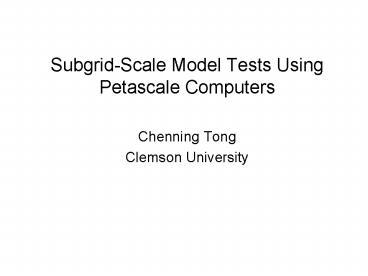SubgridScale Model Tests Using Petascale Computers - PowerPoint PPT Presentation
Title:
SubgridScale Model Tests Using Petascale Computers
Description:
Subgrid-Scale Model Tests Using Petascale Computers. Chenning Tong. Clemson University. Petascale computing facilities provide unprecedented computing ... – PowerPoint PPT presentation
Number of Views:43
Avg rating:3.0/5.0
Title: SubgridScale Model Tests Using Petascale Computers
1
Subgrid-Scale Model Tests Using Petascale
Computers
- Chenning Tong
- Clemson University
2
Petascale computing facilities provide
unprecedented computing power and great
opportunities to improve simulations Increased
resolution brings mesoscale simulations into
Terra Incognita (Wyngaard 2004) Surface layer
in LES of the atmospheric boundary layer Neither
traditional Reynolds stress nor SGS models
appropriate Model development an essential task
for improving simulation
3
Model testing an important aspect of model
development Traditional SGS model tests A
priori Compare the modeled and true SGS stress,
e.g., their correlation. Difficult to relate
test results to LES statistics (model
performance in LES) A posteriori Compare
profiles of statistics from LES and
measurements. Difficult to identify model
deficiencies from LES results. Two types of
tests disconnected. Difficult to compare.
4
The main goal for LES is to correctly predict
resolvable-scale velocity and scalar
statistics Traditional tests provide no link
between model and LES statistics A new SGS
model test approach based on the conditions
for LES to correctly predict these statistics
5
One-point velocity JPDF equation (Chen et al.
2003)
6
Necessary conditions for LES to reproduce the
JPDF The SGS model correctly predicts
and (Chen et al. 2003, Chen
Tong 2006). Production also important New
(statistical) model tests A priori compute
and using measurements
(e.g., the resolvable-scale strain rate) as model
input (Chen et al. 2003, Chen Tong 2006) A
posteriori compute and using
LES fields as model input Two types of tests
analyze the same statistics and can be compared.
7
and are conditional
means conditional on the three resolvable-scale
velocity components at the same location Three-di
mensional sample space (higher if scalars are
included), requiring large data sizes for
statistical convergence Peta-scale computers can
provide much larger data sets Larger
computational domain Longer runs Allow tests
previously not feasible
8
Field measurements (HATS 2000)
- Measurement data taken during the Horizontal
Array Turbulence Study field program in 2000. - The HATS field measurement design based on the
transverse array technique (Tong et al. 1998, ). - Moderately convective ABL
9
LES data
10
LES non-dimensional vertical shear
11
Conditional SGS shear stress
Measurement
a priori test
LES (Smagorinsky)
12
LES vertical velocity skewness
measurement
13
Conditional SGS stress production rate
Measurement
LES (Smagorinsky)
a priori test
14
The statistical a posteriori tests are based on
the variables important for the dynamics of the
SGS turbulence. Can provide new physical
understanding for mode development Peta-scale
computers can provide data sets containing much
larger amounts of independent samples, allowing
more meaningful tests previously not feasible































